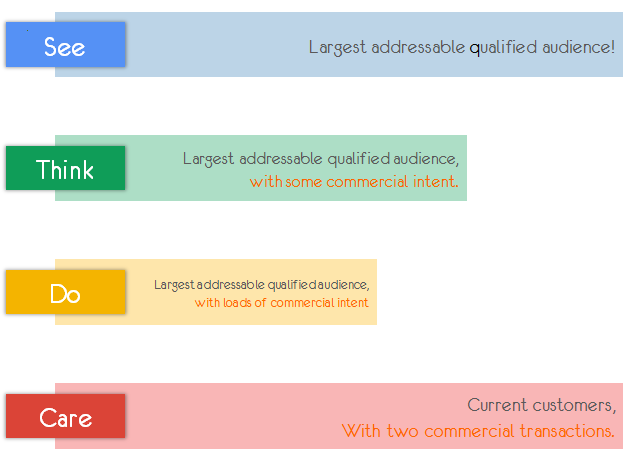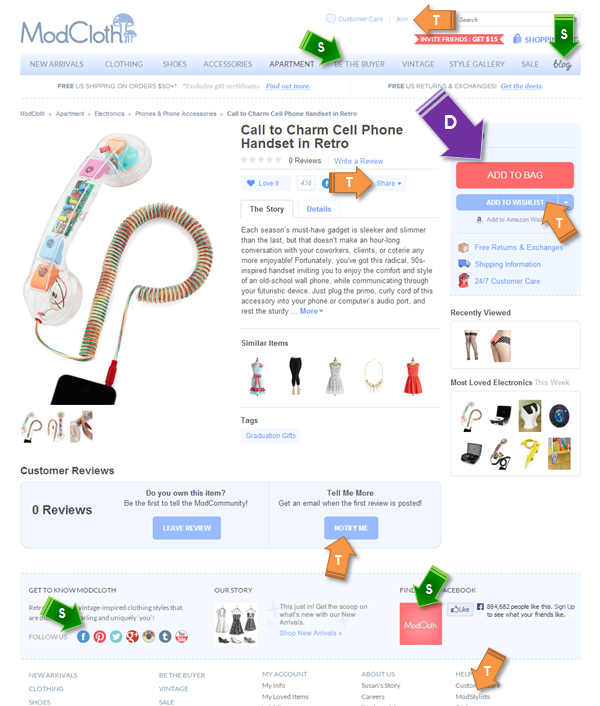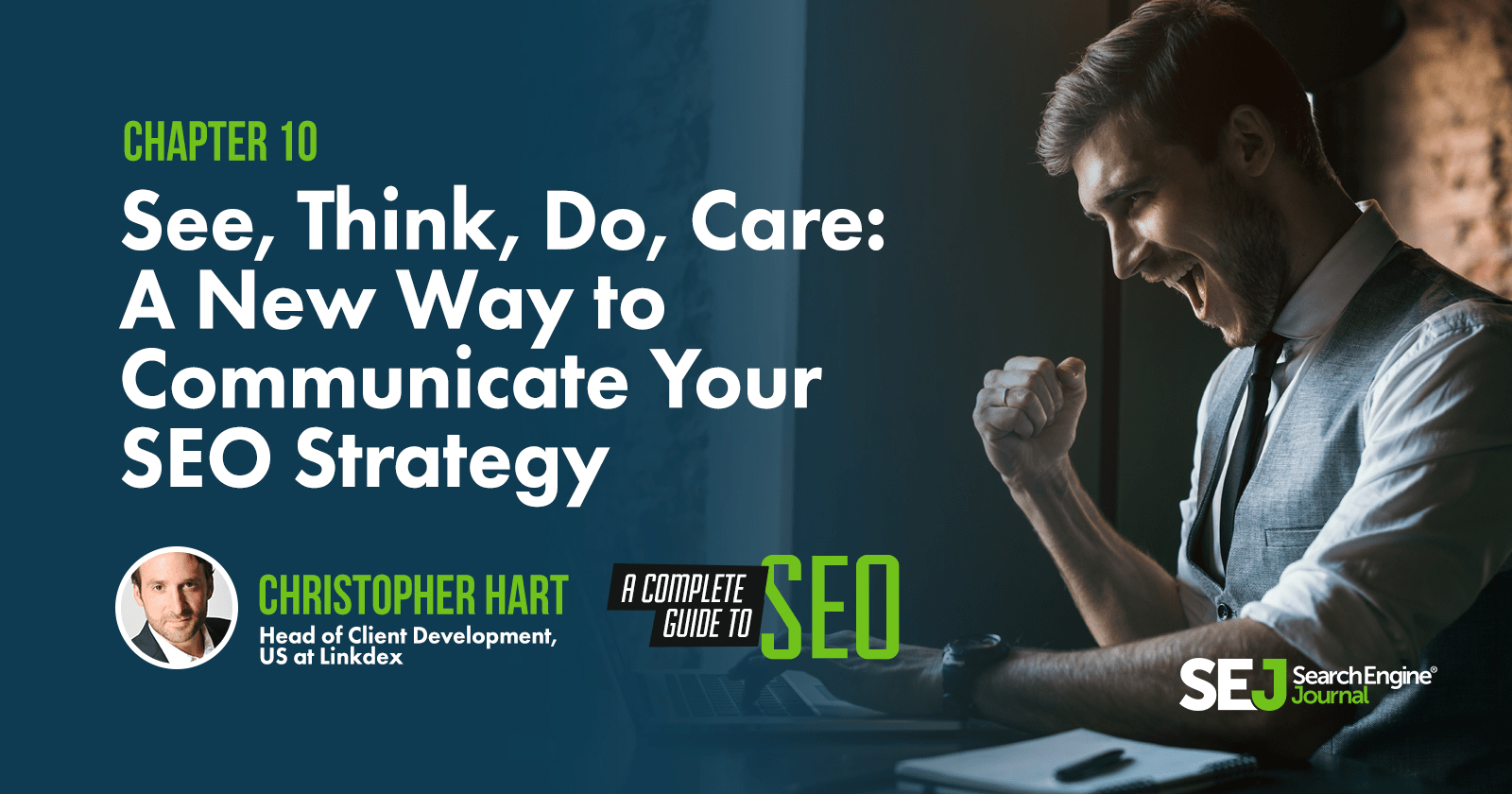When discussing SEO strategy with the C-Suite, do you ever experience your audience’s eyes glazing over?
Sure, you can try to explain website optimization in terms of the top of the funnel, mid-funnel, and bottom of the funnel; every CMO has some understanding of that. But that still doesn’t effectively capture the essence of what organic search optimization should be today.
What if I told you there’s a better way to approach discussing SEO with business stakeholders, in a language they can understand?
I’m referring to the marketing model envisioned by Avinash Kaushik, digital marketing evangelist at Google, called “See, Think, Do.” His framework applies to all types of marketing strategies, regardless of the channel.
Here’s how to apply the “See, Think, Do, Care” framework to discussions around the implementation of optimizing a website for organic search.
Understanding “See, Think, Do”
Discussing his framework in an interview with Acronym CMO Mike Grehan, Kaushik dismissed the age-old AIDA (Attention-Interest-Desire-Action) model, as well as the conventional consumer buying cycle of awareness, consideration, purchase, and loyalty.
Instead, he argues for taking a customer-oriented approach based on an understanding of the consumer’s journey. Grehan’s conversations around “intent-based digital marketing” align nicely with this notion.
According to Grehan:
“I believe when you develop content around intent and think in a more focused way about the ‘required experience’ on the customer journey, you begin to change the voice and the way you communicate, too. You begin to think more of the individual and speak in a one-to-one tone as opposed to the often copied ‘mass media audience’ voice. The fact is, nobody watches the internet. You can’t compare it to the audience-designed broadcast medium. In short: Talk to ‘me’ — not my demographic.”
(I talk about intent briefly as well in this Search Engine Journal post on fleshing out the intent behind keywords.)
In the video, Kaushik said:
“I don’t think about awareness, consideration, purchase loyalty — these standard marketing models, I hate them. So I created a new one. I call it ‘See, Think, Do.’ And what it says is that rather than thinking selfishly as a company, you have to think from a consumer perspective. … Every single person in the world is in one of these four buckets [See, Think, Do, Care].”
The buckets of consideration that Kaushik is referring to happen when an audience is on their buying journey.
- See: This stage is comprised of the largest, qualified, addressable audience.
- Think: This stage is the part of the audience that is actually thinking or considering a particular thing.
- Do: This stage is made up of that subset of the audience that is looking to buy.
Below is an illustration from Kaushik that shows the See, Think, Do framework with the types of audiences that fall into each stage of consideration (with “Care” added for established customers):

In this model, “audience intent” is defined by behavior, not demographics or psychographics, Kaushik said.
So how does this model relate to SEO strategy?
Tying it into the traditional way we think about how people search, Grehan compared See, Think, Do to search queries that are either informational, navigational, or transactional in this article.
The difference here is that the SEO of yesterday might focus on simply optimizing webpages with specific keywords from those three buckets (informational, navigational, transactional).
Today, See, Think, Do coupled with intent-based optimization is focused on what the audience is trying to accomplish, and bringing in various elements on a webpage to help them reach their goal.
Applying the See, Think, Do Framework to Website Optimization
Let’s look more closely at how you might apply the See, Think, Do framework when discussing and implementing the optimization of a website to drive organic search, conversions, and revenue.
Keep in mind that when talking about optimization, we aren’t just placing keywords; we’re creating an experience through content and the various elements on a webpage.
- See: This includes the larger audience of people online that are interested in something, and relates to the more generic search queries we see (e.g., “doorknobs”). In this phase, if you’re in the market of selling doorknobs, you might create informational content in various forms on your website about doorknobs; varieties, uses, features and benefits, installations, etc. Again, we’re thinking about the intent of the audience here.
- Think: Your audience is essentially thinking about a purchase. Your website’s job is to help that decision become easier. In this phase, you might create buying guides for doorknobs. You might also have functionality on your product pages that allow a person to compare various doorknobs.
- Do: This is enabling a conversion on the webpage, whether that’s buying a product or signing up for more information from your brand or any other type of conversion you deem important. This is usually facilitated by the elements on the webpage (for example, a noticeable “add to cart” button, an easy-to-find way to request more information or talking to customer service via chat, and so on).
Let’s remember that the traditional journey from the top of the funnel to the bottom is no longer linear. Yes, your audience will still likely go through all three phases to get to the conversion, but that doesn’t mean their actions exist in a silo.
While in the “See” phase and on an informational webpage, your audience may benefit from choices in the other phases of the journey, so that they move along at the pace they choose.
As this presentation from McKinsey & Company outlines, the consumer decision-making journey today is much more circular than linear:
See, Think, Do: An Example
Kaushik shares an illustrative example of how ModCloth employs multiple See, Think, Do elements on any given web page on their site:

Why You Can’t Afford to Ignore the New Approach
Without an understanding of what your audience is trying to do, SEO strategies today can fall short, be too prescriptive, and be too tactical.
When you implement the wrong tactics, you end up measuring the wrong things, too. As Kaushik points out here:
“Without great content, and an equally worthy marketing strategy across See-Think-Do-Care, data is almost completely useless. Scratch that. It is completely useless.”
In an era where search engines are becoming smarter at identifying the webpages that answer your audience’s intent, you can’t afford not to consider models like intent-based optimization and See, Think, Do. Without it, your chances of visibility online are becoming slimmer.
Plus, approaching your conversations with the C-Suite in a more strategic way when discussing SEO is speaking a language they can understand, and presenting a roadmap they can get behind.
Image Credits
Featured Image: Paulo Bobita
Image 1: Kaushik.net / See, Think, Do, Care Winning Combo: Content +Marketing +Measurement!
Image 2: Kaushik.net / See-Think-Do: A Content, Marketing, Measurement Business Framework





